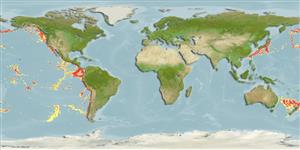sub class Elasmobranchii (ฉลามและกระเบน) (sharks and rays) >
Rajiformes (Skates and rays) >
Arhynchobatidae (Softnose skates)
Etymology: Bathyraja: Greek, bathys = deep + Latin, raja, -ae = a ray (Raja sp) (Ref. 45335); spinosissima: Name from Latin 'spinosus' meaning thorny, referring to the prickles on both the ventral and dorsal surface..
More on authors: Beebe & Tee-Van.
Environment: milieu / climate zone / depth range / distribution range
นิเวศวิทยา
เกี่ยวกับทะเล,น้ำเค็ม สัตว์หน้าดินในเขตน้ำลึก; ระดับความลึก 800 - 2938 m (Ref. 50610). Deep-water
North Pacific: from the Bering Sea, south to the Galapagos Islands and Costa Rica.
ขนาด / น้ำหนัก / Age
Maturity: Lm ? range ? - ? cm
Max length : 200 cm TL เพศผู้/กระเทย; (Ref. 126515)
Short description
เครื่องมือที่ใช้ในการแยกชนิดสัตว์,สิ่งมีชีวิตออกจากกัน | สัณฐานวิทยา | ความยาวต่างๆ
This large skates (200.3 cm TL), with large disc length and width (44.1-56.9 and 50.6-67.3% TL, respectively) are distinguished by the following: pectorals with rounded apices; head moderately long (14.0-20.5 % TL), interspiracular length large (9.1-12.2% TL), mouth width large (6.1-13.0% TL); teeth in 31-33 rows on upper jaw and in 24-31 rows on lower jaw; total vertebrae 137; dorsal and ventral surfaces are covered with prickles; thorns usually absent on dorsal surface, with tail thorns (22-28), interdorsal thorns weakly developed or absent (0-1), no middorsal, nuchal, and scapular thorns. Colouration: dorsal pale white to grey, while ventral is pale white; outer edges of pectorals dark (Ref. 126515).
Found in deep waters to almost 3,000 m, making it one of the deepest dwelling skates; prefer cold temperatures compared to its congeners. Feeds on deep-water benthic fishes. Size at maturity for males is unknown, for female specimens, size at maturity at 98 cm TL; with size at birth 25 cm TL. Egg cases are large compared to its congeners (9.2 cm TL); colour plum brown and longitudinally weakly striated, with both surfaces of the case plush-like to the touch. Horns with posterior ones curve inwards and with narrow at tips (Ref. 126515).
Life cycle and mating behavior
Maturities | การสืบพันธุ์ | Spawnings | Egg(s) | Fecundities | ตัวอ่อน
Oviparous, paired eggs are laid. Embryos feed solely on yolk (Ref. 50449). Eggs have horn-like projections on the shell (Ref. 205).
Knuckey, J.D.S. and D.A. Ebert, 2022. A taxonomic revision of Northeast Pacific softnose skates (Rajiformes: Arhynchobatidae: Bathyraja Ishiyama). Zootaxa 5142(1):1-89. (Ref. 126515)
IUCN Red List Status (Ref. 130435)
Threat to humans
Harmless
Human uses
การประมง: ไม่มีผลประโยชน์
เครื่องมือ
Special reports
Download XML
แหล่งที่มาจากอินเตอร์เน็ต
Estimates based on models
Preferred temperature (Ref.
123201): 1.6 - 2.1, mean 1.8 °C (based on 438 cells).
Phylogenetic diversity index (Ref.
82804): PD
50 = 0.5000 [Uniqueness, from 0.5 = low to 2.0 = high].
Bayesian length-weight: a=0.00513 (0.00253 - 0.01042), b=3.12 (2.95 - 3.29), in cm total length, based on LWR estimates for this Genus-body shape (Ref.
93245).
ระดับชั้นอาหาร (Ref.
69278): 4.2 ±0.8 se; based on size and trophs of closest relatives
ความสามารถในการกลับคืนสู่ปกติ (Ref.
120179): ต่ำ, เวลาต่ำสุดที่จะทำให้ประชากรเพิ่มขึ้นเป็น 2 เท่าใช้เวลา 4.5 - 14 ปี (Fec assumed to be <100).
Fishing Vulnerability (Ref.
59153): Very high vulnerability (90 of 100).
